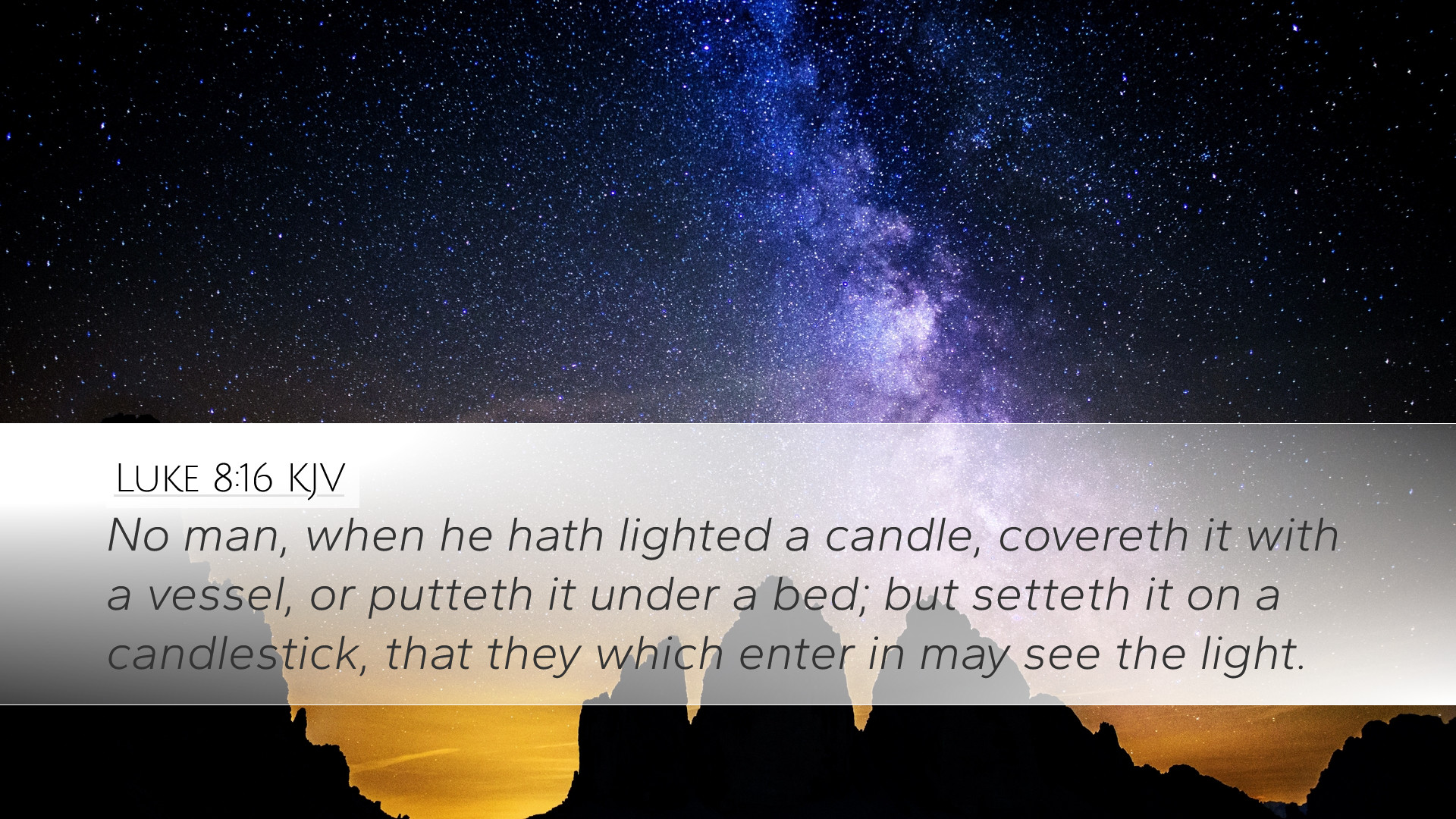Commentary on Luke 8:16
In Luke 8:16, the Scripture states: "No one, when he has lit a lamp, covers it with a vessel or puts it under a bed, but sets it on a lampstand, that those who enter may see the light." This verse is part of a larger teaching in which Jesus uses parables to convey profound spiritual truths. In this commentary, we will draw upon the insights of esteemed theologians and biblical scholars from public domain commentaries, particularly Matthew Henry, Albert Barnes, and Adam Clarke.
Context and Background
This verse follows the Parable of the Sower and illustrates the principles of revelation and the purpose of God's word in the world. Here, Jesus employs the imagery of light and lamps to emphasize the visibility and accessibility of divine truth. Understanding this verse requires a grasp of its immediate and broader contexts, including the function of parables in Jesus' teaching.
The Light of Revelation
Matthew Henry observes that a lamp is a common symbol of knowledge and revelation. This first element underscored in this verse is that the light represents the truth of the Gospel and the revelation of Christ. Just as a lamp is intended to illuminate the surroundings, so too is the message of Christ meant to enlighten those who are in spiritual darkness.
Purpose of the Lamp
Albert Barnes points out that the primary purpose of lighting a lamp is to provide illumination. He asserts that Jesus' teaching was not meant to be hidden or obscured, but to be shared openly for the benefit of all. The decision to place the lamp on a stand highlights the necessity for believers to be open and forthright about their faith.
Revelation and Responsibility
Adam Clarke adds depth to this understanding by discussing the responsibility that comes with having received the light. With revelation comes the necessity of witness. Christians, having received the light of the Gospel, are called to share it with others rather than hide it away.
Illustration of Intentionality
The metaphor of the lamp also speaks to the intentionality of believers in revealing God's truth. The act of lighting a lamp and placing it on a stand reflects a deliberate choice to bring awareness to others. As followers of Christ, believers must take active steps in their lives to ensure that the message of Jesus is visible and accessible to the world around them.
Covering the Light
Henry emphasizes that covering a lamp would be counterproductive. Similarly, when believers conceal their faith or fail to live out their convictions, they hinder the very purpose of their spiritual illumination. The act of placing a lamp under a bed serves as a poignant reminder of how one’s circumstances or fears may lead them to hide their light instead of allowing it to shine.
Applications for Pastoral Ministry
This passage holds significant implications for pastoral ministry. Pastors are called to be shepherds of light, illuminating the paths for those entrusted to their care. They must be conscientious not to hide their light but rather cultivate environments where Christ's truth can flourish. As they share the Gospel, they play a critical role in helping others recognize the light and guiding them toward it.
Encouraging Boldness
Encouraging congregants to be bold in their faith is vital. Barnes indicates that believers should overcome shyness or shame in sharing their testimonies. The calling to be a light bearer is not limited to leaders; it extends to all believers. In practical terms, this could mean engaging in community outreach, sharing the Gospel in everyday conversations, or supporting missionary efforts.
Scholarly Perspectives
The scholarly reflections on this verse underscore the theological weight behind the simplicity of the metaphor. It compels both individual believers and the church as a collective to consider: What does it mean to embody the light of Christ? How can believers better position themselves to allow that light to shine in a dark world?
Theological Implications
Clarke notes that the phrase "those who enter" indicates an invitation to understand the truth of the Gospel. There is an expectation that those who encounter the light will be changed by it. This idea raises questions about the nature of faith and the transformative power of encountering Christ; it invites theologians to reflect on the implications of discipleship as being not just about seeing the light but actively participating in its dissemination.
Conclusion
Luke 8:16 serves as a powerful challenge to believers regarding their posture toward the light of truth they have received. It encapsulates the essence of the Christian call not just to understand but to illuminate the world with the revelations of God’s love and grace. As pastors, students, theologians, and scholars engage with this passage, may they recognize the profound responsibility and joy that comes with being bearers of the light of Christ.
Reflection Questions
- In what ways are we intentionally placing our light on a lampstand for others to see?
- What barriers might be causing us to hide our light, and how can we overcome them?
- How can our communities better reflect the light of Christ in tangible ways?


